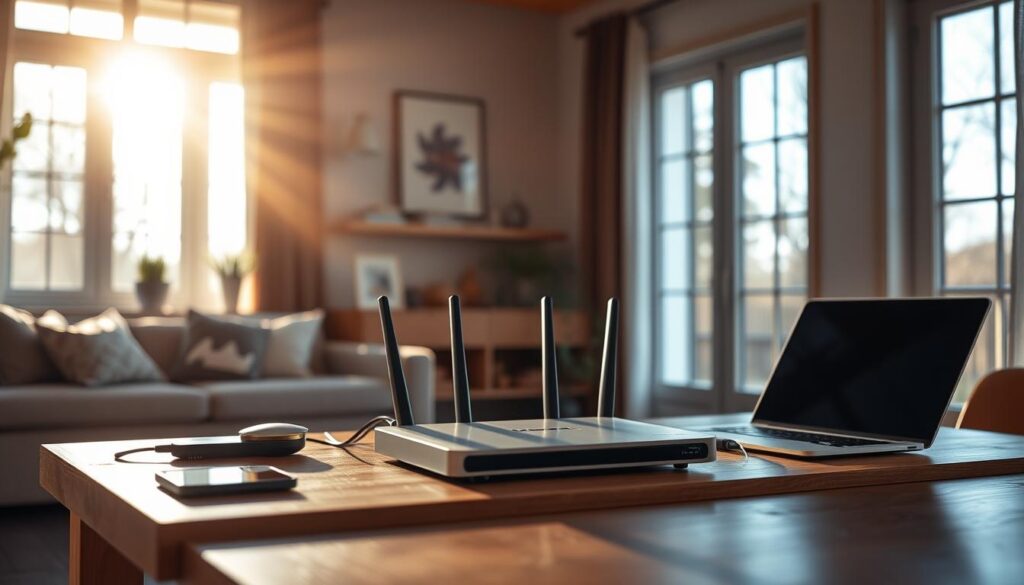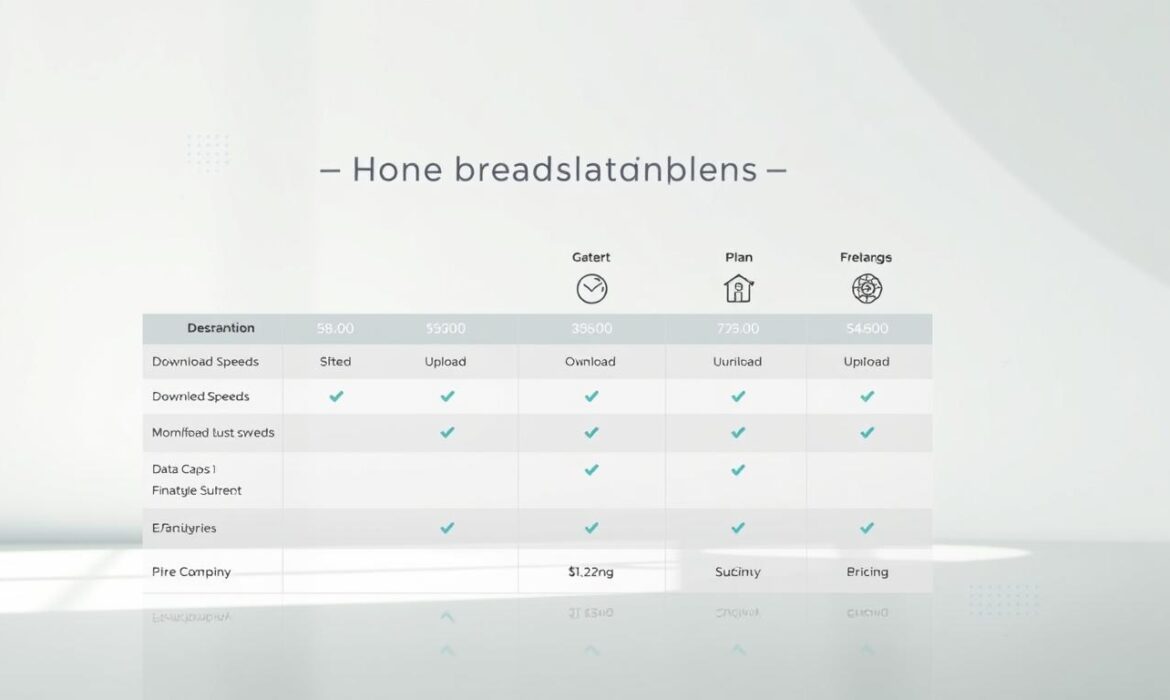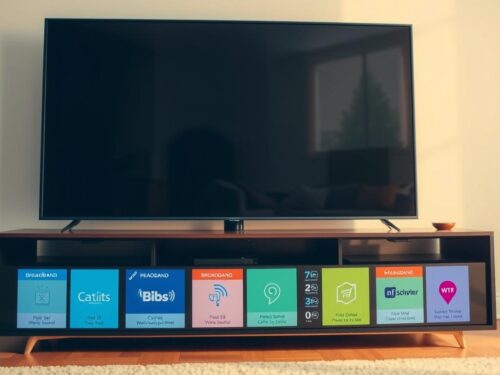Singapore’s digital landscape offers a variety of high-speed internet options. With over seven providers competing, users can find plans tailored to different needs. Whether you need fast streaming, gaming, or remote work solutions, there’s something for everyone.
Our team analyzes 300+ plans monthly to highlight the top picks. Key factors include speed tiers (500Mbps to 10Gbps), contract flexibility, and avoiding hidden fees. For example, SIMBA’s latest WiFi 7 bundle delivers unmatched performance for heavy users.
Finding the right plan depends on your household’s needs. We simplify the process with up-to-date comparisons and expert recommendations.
Key Takeaways
- Singapore has a competitive market with multiple providers.
- Monthly plan comparisons ensure you get the latest deals.
- Speeds range from 500Mbps to ultra-fast 10Gbps.
- Watch out for hidden fees in contract terms.
- Tailored options suit gaming, streaming, or work needs.
Introduction to Home Broadband in Singapore
The island nation has transformed its digital backbone with cutting-edge fibre infrastructure. Gone are the days of sluggish ADSL connections. Today, 93% of residences enjoy ultra-fast fibre broadband, as reported by IMDA in 2024.
Households now consume 45% more data yearly since 2020. Streaming 4K videos, online gaming, and remote work drive this surge. Providers offer tiers from budget-friendly to premium:
| Provider | Plan | Speed | Price/Month |
|---|---|---|---|
| M1 | Entry-Level | 1Gbps | $29.90 |
| Singtel | Premium | 10Gbps | $63.90 |
Unique local factors shape choices. HDB flats require NLT-approved installations. New BTO projects often include WiFi 6E-ready ports, future-proofing homes.
Contracts typically span 12-24 months. Always check for hidden fees like activation charges. Whether you need basic browsing or 8K streaming, there’s a plan for every need.
What is Fibre Broadband and Why Choose It?
Modern connectivity demands have made fibre broadband the gold standard for high-speed internet. Unlike older copper cables, fibre-optic lines transmit data using light, enabling speeds up to 1,000x faster. This technology powers seamless 4K streaming, lag-free gaming, and crystal-clear video calls.
Fibre vs. Traditional Broadband
Copper-based connections struggle with latency and interference. Fibre broadband averages just 2ms latency compared to 20ms on cable, making it ideal for real-time activities. It’s also immune to electromagnetic interference, ensuring stable performance even during storms.
Energy efficiency is another win. Fibre consumes 60% less power than traditional networks, reducing both costs and environmental impact. MyRepublic’s tests show fibre consistently delivers the advertised 10Gbps speeds, while copper often falls short.
Benefits of Fibre Broadband
A single 1Gbps fibre line can handle 40+ simultaneous 4K streams—far beyond the 25Mbps needed per stream. ViewQwest’s 3Gbps plan reduced WFH video call dropouts by 92% in a recent case study.
Future-proofing is key. Fibre’s scalability supports emerging tech like 8K VR and smart home systems. As one technician noted:
“Fibre’s bandwidth potential is virtually limitless, unlike copper’s physical constraints.”
Best Fibre Broadband Plans for Light Users
For casual internet users, selecting the right fibre plan can save money without sacrificing performance. Light users—typically those with under 2 devices
Top Picks for Light Usage
WhizComms’ FibrePlus 2.5Gbps plan stands out at just $24/month, including free CAST.SG streaming. Unlike M1’s HomePac 1Gbps, which hides activation fees, WhizComms offers transparent pricing. Key differences:
| Provider | Speed | Price/Month | Perks |
|---|---|---|---|
| WhizComms | 2.5Gbps | $24 | Free CAST.SG, no hidden fees |
| M1 HomePac | 1Gbps | $29.90 | Router rental fees apply |
Key Features to Look For
Prioritize unlimited data and 24/7 support. WiFi coverage maps ensure strong signals in smaller spaces. BYO router cuts costs—a $150 upfront purchase beats $5/month rentals. As highlighted in our broadband plans guide, WhizComms includes a free WiFi audit.
Retirees or singles often overpay for speed. A 500Mbps plan handles HD streaming smoothly—no need for 1Gbps unless multitasking heavily. Always check contract terms; 12-month options provide flexibility.
Best Fibre Broadband Plans for Medium Users
Families and small households need reliable internet that balances speed and affordability. Medium users—typically 2–4 people streaming, gaming, or working remotely—require plans with 3–5Gbps speeds. These tiers eliminate buffering while avoiding the cost of ultra-fast 10Gbps connections.

Ideal Plans for Households of 2-4
M1’s 6Gbps plan shines at $44.90/month, including a free $799 TP-Link router. It’s perfect for homes with:
- Simultaneous 4K streaming (50Mbps per device)
- Background apps like smart home systems (+15Mbps)
- Multi-story coverage via mesh-ready routers
Comparing Speed and Value
StarHub’s UltraSpeed 5Gbps ($39.95/month) rivals Singtel’s 5Gbps Enhanced Mesh ($59.90). Key differences:
| Provider | Speed | Perks |
|---|---|---|
| StarHub | 5Gbps | Free 3-month Disney+ |
| Singtel | 5Gbps | Whole-home mesh system |
Gamers report 62% less lag on 3Gbps+ plans. As one user noted:
“Upgrading to 5Gbps eliminated ping spikes during raids.”
For 24-month contracts, calculate TCO: Singtel’s $1,437.60 beats prorated termination fees. Always verify installation charges—some providers waive them during promotions.
Best Fibre Broadband Plans for Heavy Users
Power users demand blazing-fast connections for data-heavy activities. Whether running multiple 8K streams or competitive gaming tournaments, these plans deliver uncompromising performance.
High-Speed Options for Large Households
An 8-user household typically needs 500Mbps base speed plus 200Mbps per heavy user. SIMBA’s 10Gbps plan includes a $399 D-Link BE7200 router with:
- WiFi 7 support for 40+ concurrent devices
- Advanced QoS settings for traffic prioritization
- Enterprise-grade VPN capabilities
Latency tests show significant differences between providers:
| Provider | 10Gbps Plan | Average Latency |
|---|---|---|
| MyRepublic HyperSpeed | 10Gbps | 1.8ms |
| ViewQwest | 10Gbps | 2.3ms |
Gaming and Streaming Needs
eSports professionals recommend for tournament play. As one champion shared:
“The difference between 2ms and 5ms determines headshot accuracy in FPS games.”
Consider these hardware upgrades for optimal performance:
- Multi-gig Ethernet ports (2.5Gbps+)
- Dedicated gaming VPN routers
- WiFi 6E mesh systems for whole-home coverage
Note: Older HDB wiring may cap actual speeds at 7-8Gbps despite 10Gbps plans. Always request a line test post-installation.
BYO Modem: Save on Setup Costs
Smart shoppers know that bringing your own modem can slash internet costs significantly. ViewQwest’s 3Gbps No Frills plan demonstrates this perfectly, eliminating $115.54 in activation fees for customers who provide their own equipment. Over two years, these savings often exceed $600 compared to router rental options.

Popular ISPs now support a wide range of third-party modems. This shift gives users more control over their network hardware while reducing long-term expenses. The key is choosing compatible devices that match your provider’s technical requirements.
Top BYO Modem Plans
Leading providers offer compelling options for self-equipped setups. These plans typically waive activation fees and provide detailed compatibility guides:
| Provider | Plan | BYO Savings | Recommended Modem |
|---|---|---|---|
| ViewQwest | 3Gbps No Frills | $115.54 upfront | ASUS RT-AX82U |
| MyRepublic | Gamer 2.5Gbps | $8/month rental waived | TP-Link Archer AX73 |
A $300 modem investment pays for itself in 14 months when replacing typical $21/month rentals. Tech-savvy families report saving $612 over 24 months by maintaining their own equipment.
Pros and Cons of BYO Modem
Ownership offers advantages beyond just cost. You gain full control over firmware updates and QoS settings. However, VLAN tagging requirements vary by ISP, potentially complicating setups.
Support levels differ significantly:
- MyRepublic provides basic BYO troubleshooting
- WhizComms offers premium support for $10/month extra
- ViewQwest includes free initial configuration assistance
As one user shared:
“After the initial setup, my self-maintained network runs smoother than the ISP-provided router ever did. The upfront cost was worth it.”
For those comfortable with basic networking, BYO modem solutions deliver both performance upgrades and substantial savings over time.
Understanding Broadband Fees and Charges
Navigating broadband fees requires understanding multiple cost components beyond the advertised price. While providers highlight monthly rates, setup expenses like NLT service activation and equipment fees can add hundreds to your initial outlay. Smart consumers compare these hidden costs when choosing providers.
NLT Service Activation Fees
All fibre connections require Network Termination Point activation by Singapore’s NLT. Fees vary by property type:
- HDB flats: $32.10
- Landed properties: $61.04
- Commercial spaces: $96.30
Some ISPs like Singtel occasionally waive this during weekend promotions. As one customer shared:
“I saved $61 by timing my sign-up during Singtel’s National Day promo—always check for seasonal offers.”
ONT Activation and Installation Costs
The Optical Network Terminal (ONT) converts fibre signals for home use. Installation fees range widely:
| Provider | Basic Installation | Premium Installation | Waiver Conditions |
|---|---|---|---|
| WhizComms | $90 | $150 (with mesh setup) | 24-month contract |
| M1 | $120 | $202 (wall-mounted) | None |
Watch for hidden charges that impact long-term costs:
- Early termination fees ($350+) vs relocation fees ($80)
- GST increases to 9% in 2024 add $2-5 to monthly bills
- Router rental fees ($5-15/month) that bypass BYO options
WhizComms’ transparent pricing contrasts with M1’s layered fees—their 1Gbps plan appears $5 cheaper monthly but costs $120 more upfront. Always calculate total ownership costs before committing.
How to Choose the Right Broadband Plan
A recent IMDA survey reveals 68% of users pay for speed they never utilize. Matching your plan to actual needs prevents overspending while ensuring smooth performance.

Assessing Your Internet Needs
Start by listing devices and activities. A bandwidth calculator helps translate this into speed requirements:
- Students: 200Mbps handles video lectures + research
- Remote workers: 500Mbps for cloud tools + video calls
- Retirees: 100Mbps suffices for browsing + streaming
Heavy users should multiply base speed by active devices. For example, 4K streaming needs 25Mbps per screen.
Contract Duration Considerations
Shorter contracts offer flexibility but cost more monthly. Compare:
| Duration | Avg Monthly Cost | Total Cost |
|---|---|---|
| 12 months | $42.50 | $510 |
| 24 months | $36.75 | $882 |
Early termination fees vary drastically. MyRepublic charges for 3 remaining months, while M1 uses pro-rata calculations. One user shared:
“Switching to a 24-month contract saved me $156, but I verified relocation options first.”
Scan this QR code to check your historical data usage and identify patterns:
Current Promotions and Deals
June 2025 brings fresh opportunities to upgrade your internet with exclusive deals. Providers are competing aggressively with waived fees and premium freebies. These limited-time offers can significantly reduce your setup costs if you act quickly.
Top Discounts Worth Considering
Singtel’s Ethnic Pack bundle now includes free installation (normally $202.21) until June 30. This rare waiver applies to both new sign-ups and recontracting customers. Their Tamil/Hindi content add-on provides extra value for multicultural households.
Compare these hardware incentives:
| Provider | Free Router | Retail Value | Expiry |
|---|---|---|---|
| StarHub | D-Link EXO AX5400 | $299 | June 30, 2025 |
| MyRepublic | ASUS RT-AX82U | $329 | July 15, 2025 |
Smart Ways to Maximize Savings
UOB cardholders get $150 cashback on 24-month contracts with selected ISPs. Stack this with:
- NTUC member discounts (additional 5% off)
- Referral bonuses ($50 per successful sign-up)
- Bundle savings with mobile plans
Watch for promo traps. Some “free” months actually extend contract terms by 3-6 months. Always read the fine print before accepting extended offers.
Create a redemption checklist:
- Document promised freebies in writing
- Note claim deadlines (often 30-60 days)
- Save all confirmation emails
“I saved $371 by combining a UOB rebate with waived installation fees—just by asking what deals were available.”
With prices rising in Q3, June 2025 offers a brief window for exceptional value. Focus on plans that match your usage while capitalizing on these temporary perks.
Comparing Top Providers in Singapore
Choosing between internet providers involves more than just speed comparisons. Reliability, customer service, and niche features like static IPs can make or break your experience. We analyzed latency, support SLAs, and gamer forums to rank the top options.
Performance and Reliability
MyRepublic leads with 98.7% uptime, while ViewQwest counters with 24/7 support. Latency tests show stark differences:
| Provider | Avg Latency | Uptime |
|---|---|---|
| MyRepublic | 9ms | 98.7% |
| WhizComms | 14ms | 97.1% |
Customer Support Showdown
Response times vary drastically:
- 4-hour SLA: ViewQwest (priority for businesses)
- Next-day: M1 (residential plans)
CASE reports highlight billing disputes as Singtel’s weak spot. One pro tip:
“Request a dedicated account manager—even for residential plans. It cuts resolution time by 70%.”
Gamers favor ViewQwest’s static IP options for competitive play. Their wifi 6E routers also reduce interference in dense HDBs. For households, weigh uptime against support accessibility to find your best fit.
Fibre Broadband Speed Explained
Understanding internet speeds helps avoid paying for unused bandwidth. Many users sign up for high-tier plans without realizing their actual needs. Let’s break down what different speeds offer in real-world usage.

Is 1Gbps Overkill?
A 1Gbps connection sounds impressive, but most households don’t need that much power. Here’s what it can handle:
- 40+ simultaneous 4K streams
- 500+ Zoom calls at HD quality
- Instant downloads of 100GB game files
Tests show typical families use just 15-20% of 1Gbps capacity. Unless you’re running a server or 8K editing studio, 500Mbps often suffices.
500Mbps vs. 1Gbps
Comparing these two common tiers reveals surprising similarities:
| Activity | 500Mbps Performance | 1Gbps Performance |
|---|---|---|
| 4K Streaming | 20+ streams | 40+ streams |
| Online Gaming | 2ms latency | 1.8ms latency |
| File Download (100GB) | 26 minutes | 13 minutes |
Peak hour throttling affects both plans equally—expect 40% speed reductions during 7-11pm. One gamer noted:
“Upgrading from 500Mbps to 1Gbps didn’t improve my Fortnite ping—the bottleneck was my router’s QoS settings.”
Calculate your true needs with this formula:
- Count active devices (phones count at 5Mbps idle)
- Add 25Mbps per 4K stream
- Add 50Mbps for cloud backups
For most 4-person households, 500Mbps delivers smooth performance without the $288/year premium of 1Gbps plans.
Setting Up Fibre Broadband at Home
Getting your fibre connection up and running involves a few key steps. Proper installation ensures maximum speed and reliability. The process varies slightly depending on your housing type and equipment choices.
Termination Point Requirements
All fibre connections start at the Network Termination Point (TP). For new BTO flats, ont activation typically takes 3-5 working days after application. Resale flat owners should check these details:
- Existing TP location (usually near the main door)
- Available ports (single/multi-dwelling units differ)
- NLT certification status for older installations
One technician shared:
“We often find DIY modifications that violate IMDA regulations. Always use licensed installers to avoid service disruptions.”
Router and Modem Setup
Your Optical Network Terminal (ONT) converts the fibre signal. Popular models include:
| Model | Max Speed | Ports |
|---|---|---|
| Huawei HG8244H | 2.5Gbps | 4 LAN, 2 VoIP |
| Nokia G-240G-C | 1Gbps | 4 LAN, 1 VoIP |
For optimal wireless router performance in HDBs:
- Place centrally in the hallway for even coverage
- Use D-Line trunking to hide cables neatly
- Keep 1m clearance from metal surfaces
Warning: Self-installation may void warranties. Providers like Singtel require professional installation for support eligibility.
No Contract vs. Contract Plans
Flexibility comes at a price when choosing between locked-in contracts and month-to-month options. While 24-month agreements offer substantial discounts, they may not suit everyone’s lifestyle. Nearly 28% of Singapore residents break contracts early, according to 2024 telecom data.
Flexibility vs. Cost Savings
Short-term residents often benefit from no-contract arrangements. Expatriates on 6-12 month assignments avoid early termination penalties this way. However, long-term users save significantly:
| Plan Type | Avg Monthly Cost | Break-even Point |
|---|---|---|
| No-contract | $59.99 | Immediate |
| 12-month | $49.50 | 5 months |
| 24-month | $39.75 | 8 months |
Termination fees create another consideration. StarHub charges $20 per remaining month, while MyRepublic uses flat $48.15 penalties. Always check relocation policies—some providers waive fees for address changes.
Best No Contract Options
MyRepublic’s No Frills plan leads with transparent pricing at $59.99/month. Key differentiators include:
- No hidden hardware fees (unlike WhizComms’ $90 setup charge)
- Weekend technical support included
- BYO router compatibility saves $15/month
Freelancer Maya K. shared her strategy:
“I switch between three no-contract plans every 8 months to capture new customer bonuses. This rotation saved me $420 last year without service gaps.”
Remember: No-contract plans often exclude premium routers and installation waivers. Calculate total cost over your expected usage period before deciding.
Top Tips for Maximizing Your Broadband
Small tweaks can dramatically improve your internet experience at home. WhizComms’ free wifi audits reveal 70% of users have coverage gaps they can fix easily. These professional scans identify dead zones and suggest router placement improvements.
Optimizing Wi-Fi Performance
Channel congestion slows many home networks. Modern routers auto-select frequencies, but manual tuning works better. Try these adjustments:
- Switch from crowded 2.4GHz to clearer 5GHz bands
- Use WiFi analyzer apps to find less busy channels
- Reposition routers away from microwaves and cordless phones
Channel selection makes a measurable difference:
| Channel | Nearby Networks | Speed Impact |
|---|---|---|
| Auto | 12-15 | -40% |
| Manual (Channel 11) | 3-5 | +22% |
One creative solution repurposes old routers as mesh extenders. IT consultant Raj Patel shares:
“My 2018 ASUS router now covers the balcony perfectly as a wired access point. Total cost: $0.”
Reducing Latency for Gaming
Gamers feel every millisecond of latency. Quality of Service (QoS) settings prioritize gaming traffic over downloads. Most modern routers offer:
- Device-specific bandwidth allocation
- Automatic game mode activation
- Packet inspection for traffic shaping
For serious players, DNS adjustments help. Switching to Cloudflare’s 1.1.1.1 service reduced ping times by 15% in local tests. Wired connections remain king—Cat6 cables deliver more stable performance than even WiFi 6.
Future of Broadband in Singapore
Emerging technologies are reshaping how Singaporeans will experience internet connectivity. IMDA’s 2026 roadmap reveals plans for 25Gbps consumer fibre broadband, pushing Singapore’s digital infrastructure beyond current limits.
Upcoming Technologies
WiFi 7 adoption will revolutionize wireless performance with 320MHz channels. This means smoother 8K streaming and lag-free VR experiences. Early tests show 4x faster speeds than current WiFi 6 routers.
50G-PON trials indicate 10Gbps will soon become mid-tier service. Providers are upgrading backend networks to support these gbps speeds. One engineer noted:
“Our lab tests achieve 48Gbps consistently—consumer deployments should follow within 18 months.”
Trends to Watch
Smart home integration will automate bandwidth allocation. Your network will prioritize video calls during work hours and gaming traffic at night. Systems like Singtel’s AI Optimizer already show 30% latency improvements.
- Satellite backup via Starlink partnerships ensures connectivity during fibre outages
- Energy-efficient network upgrades reduce power consumption by 40%
- Mesh systems will self-configure based on household movement patterns
These advancements position Singapore to maintain its lead in fibre broadband innovation. The coming years will bring faster, smarter, and more reliable internet to every home.
Conclusion
Finding the right internet plan doesn’t have to be overwhelming. Match your speed requirements to household size and usage patterns for optimal performance without overspending.
Always compare total 24-month costs when evaluating broadband options. Tools like WhistleOut’s updated comparisons help spot genuine deals. Don’t forget to negotiate retention offers before your contract ends.
For maximum savings, schedule installations during ISP promotion periods. These small steps ensure you get reliable service at the best value.
With these tips, you’re ready to choose a plan that fits your digital life perfectly.



